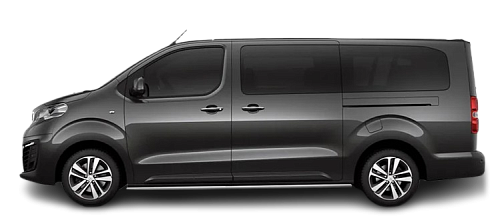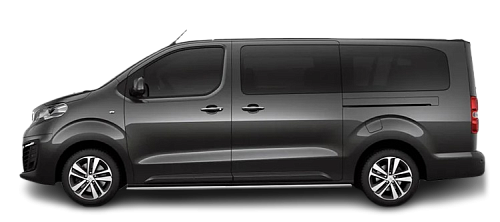USA EV Comparison: Peugeot e-Traveller Standard 50 kWh vs e-Traveller Standard 75 kWh
Struggling to Decide? Let AI Help!
Your AI Summary Is Ready!
General Info
Both vehicles have been discontinued and were never available for sale in the United States.
The two vehicles share the same body style: Minivan.
| Property | Peugeot e-Traveller Standard 50 kWh | Peugeot e-Traveller Standard 75 kWh |
|---|---|---|
| Years of Production | 2020-2024 | 2021-2024 |
| Current Status | Discontinued | Discontinued |
| Country of Manufacture | France, Turkey, UK | France, Turkey, UK |
| Body Style | Minivan | Minivan |
| Market Availability | EU | EU |
| GCC Score | 4.9 | 5.1 |
Range and Efficiency
While the Peugeot e-Traveller Standard 75 kWh (2021-2024) offers a longer real-world range and a bigger battery, it is less energy-efficient than the Peugeot e-Traveller Standard 50 kWh (2020-2024).
| Property | Peugeot e-Traveller Standard 50 kWh | Peugeot e-Traveller Standard 75 kWh |
|---|---|---|
| Range (WLTP) | 140 mi | 200 mi |
| Range (GCC) | 119 mi | 170 mi |
| Battery Capacity (Nominal) | 50 kWh | 75 kWh |
| Battery Capacity (Usable) | 46.3 kWh | 68 kWh |
| Efficiency per 100 mi | 38.9 kWh/100 mi | 40 kWh/100 mi |
| Efficiency per kWh | 2.57 mi/kWh | 2.5 mi/kWh |
| Range and Efficiency Score | 2.8 | 3.2 |
Charging
Both vehicles utilize a standard 400-volt architecture.
The Peugeot e-Traveller Standard 50 kWh (2020-2024) offers faster charging speeds at DC stations, reaching up to 101 kW, while the Peugeot e-Traveller Standard 75 kWh (2021-2024) maxes out at 100 kW.
Both vehicles are equipped with the same on-board charger, supporting a maximum AC charging power of 7.4 kW.
| Property | Peugeot e-Traveller Standard 50 kWh | Peugeot e-Traveller Standard 75 kWh |
|---|---|---|
| Max Charging Power (AC) | 7.4 kW | 7.4 kW |
| Max Charging Power (DC) | 101 kW | 100 kW |
| Architecture | 400 V | 400 V |
| Charge Port | CCS Type 2 | CCS Type 2 |
| Charging Score | 4.3 | 4.8 |
Performance
Both vehicles are front-wheel drive.
Both cars offer the same motor power, but the Peugeot e-Traveller Standard 50 kWh (2020-2024) achieves a faster 0-60 mph time.
| Property | Peugeot e-Traveller Standard 50 kWh | Peugeot e-Traveller Standard 75 kWh |
|---|---|---|
| Drive Type | FWD | FWD |
| Motor Type | PMSM | PMSM |
| Motor Power (kW) | 100 kW | 100 kW |
| Motor Power (hp) | 134 hp | 134 hp |
| Motor Torque | 192 lb-ft | 192 lb-ft |
| 0-60 mph | 12.6 s | 13.8 s |
| Top Speed | 81 mph | 81 mph |
| Performance Score | 1.9 | 1.8 |
Dimensions
The Peugeot e-Traveller Standard 50 kWh (2020-2024) and Peugeot e-Traveller Standard 75 kWh (2021-2024) are about the same size.
Both models have similar wheelbase lengths.
| Property | Peugeot e-Traveller Standard 50 kWh | Peugeot e-Traveller Standard 75 kWh |
|---|---|---|
| Length | 195.2 in | 195.1 in |
| Width (with Mirrors) | 86.8 in | 86.8 in |
| Width (w/o Mirrors) | 75.6 in | 75.6 in |
| Height | 73.9 in | 74.4 in |
| Wheelbase | 128.9 in | 128.9 in |
Cargo and Towing
Both models provide equal trunk space and the same total cargo volume when the rear seats are folded.
Neither car is equipped with a frunk (front trunk).
When it comes to towing, both cars offer identical towing capacity (up to 2205 lb).
| Property | Peugeot e-Traveller Standard 50 kWh | Peugeot e-Traveller Standard 75 kWh |
|---|---|---|
| Number of Seats | 5, 6, 7, 8, 9 | 5, 6, 7, 8, 9 |
| Curb Weight | 4341 lb | 4698 lb |
| Cargo Volume (Trunk) | 21.3 ft3 | 21.3 ft3 |
| Cargo Volume (Max) | 108.1 ft3 | 108.1 ft3 |
| Cargo Volume (Frunk) | - Cargo Volume (Frunk) | - Cargo Volume (Frunk) |
| Towing Capacity | 2205 lb | 2205 lb |
| Cargo and Towing Score | 8.6 | 8.7 |




